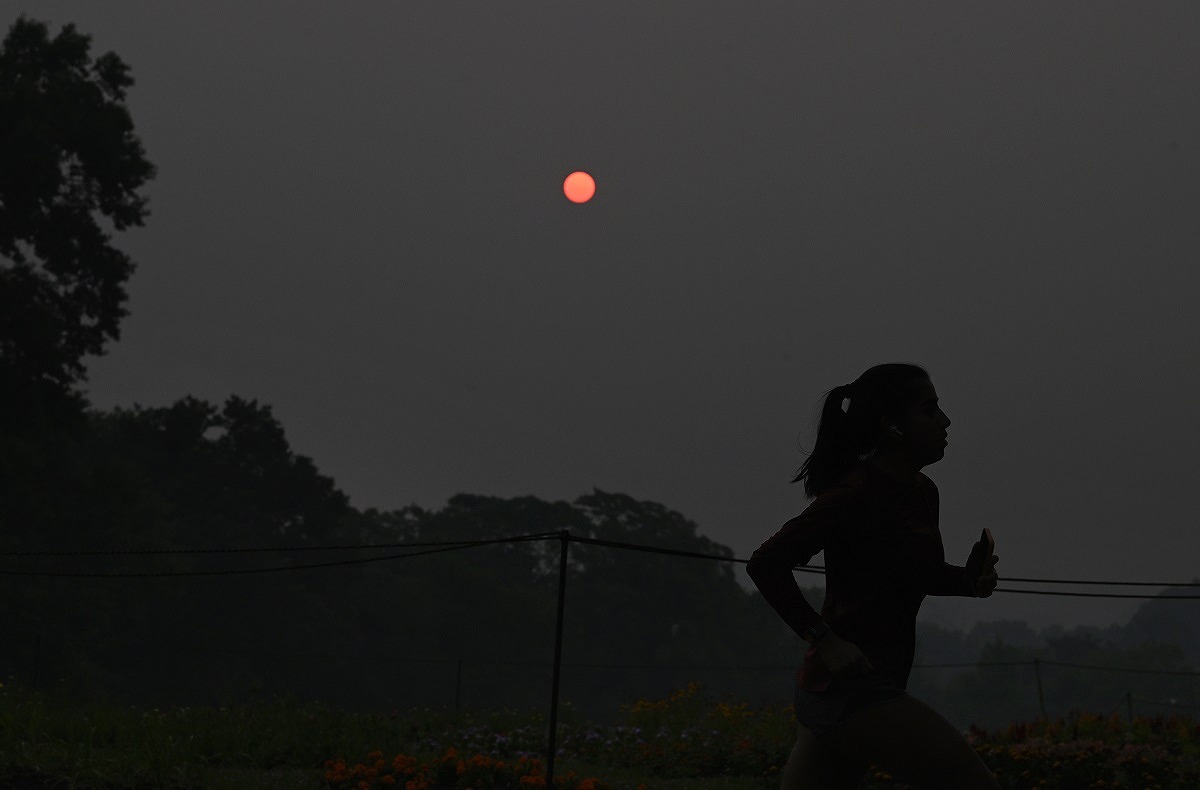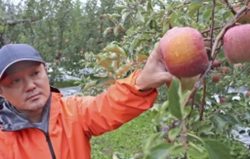
The rising sun appears orange behind a runner on June 8, 2023, in Arlington, Va., just outside Washington, D.C.
15:14 JST, June 9, 2023
Smoke from Canadian wildfires inflicted unprecedented air pollution across the Washington, D.C., region and much of the northeastern United States on Thursday, forcing the cancellation of outdoor activities from professional sports to trash collection, and sparking anxiety about whether the event could be a harbinger of what life will look like on a hotter planet.
Largely spared up to now, the East is now feeling, breathing and tasting the acrid, hazardous air that has increasingly plagued fire-scorched Western states in recent years. New York City broke records for bad air quality this week, logging the worst air of any major city in the world. And in D.C. on Thursday, Major League Baseball postponed a game, National Zoo officials shuttered exhibits, and local authorities warned people and pets to stay indoors or face health risks.
As smoke drifted from historic wildfires in Canada to the East Coast, President Biden called the air quality crisis “another stark reminder of the impacts of climate change.” Since May, the United States has deployed hundreds of firefighters, support personnel and firefighting assets such as air tankers to Canada, and was ready to respond with more, he said.
After the haze in Manhattan hit its worst levels on Wednesday, it appeared to be temporarily making way for slightly sunnier skies Thursday afternoon, and some people strolled around unmasked. But in Washington, Thursday’s air was smokier than Wednesday’s, and the problem was “likely to continue or worsen through Friday,” according to a statement from the D.C. mayor’s office.
Mayor Muriel E. Bowser (D) urged everyone to stay indoors as much as possible or wear an N95 or KN95 mask. “If you don’t have to be outside, then don’t be outside,” she said at a news conference on an unrelated topic Thursday. “I don’t know that we’ve ever experienced it so poorly.”
The Metropolitan Washington Council of Governments and the D.C. Department of Energy and Environment issued a “Code Purple” air quality alert, indicating very unhealthy air conditions for everyone, not just those with respiratory illnesses. Code Purple is the second worst of six color-coded levels in the Air Quality Index, or AQI. (In 2012, the region recorded two days for ozone pollution that would qualify as Code Purple by the current standards, enacted in 2015, the council said.)
The Franconia area, in southern Fairfax County, Va., reported Code Maroon air quality levels Thursday morning – the worst level in the AQI, signifying “hazardous conditions.”
Philadelphia also reported Code Maroon levels on Thursday morning. In the city’s Italian Market on South Ninth Street, Wally Giordano, the 63-year-old owner of P&F Giordano Italian Market, said the air quality hadn’t affected him or his employees, but business was definitely down.
“Usually we’re busy as hell every day out here, running around. I clock 30,000 steps a day trying to make sure things are okay,” he said. “. . . We’ve been here for 101 years, and my grandmother would roll over in her grave if something ever happened to this place.”
The pandemic had seriously harmed the business, Giordano said, so he had an unpleasant flashback after he left work yesterday. “Everybody went back to wearing masks again,” said Giordano. “I was thinking, ‘Oh, god. I never want to see anything like that again.'”
Around the D.C. region, residents strapped on masks to walk their dogs, water their gardens and go to work. Families who typically walk to school quickly arranged for carpools to minimize outdoor exposure. By midday Thursday, some local hardware stores said they had sold out of air purifiers and surgical-style masks.
MLB canceled the 1:05 p.m. Washington Nationals game against the Arizona Diamondbacks and rescheduled it for the same time on June 22. Officials at the National Zoo in D.C. tweeted that “for the safety of our animals, our staff and our guests,” they had decided to close for the day.
New York City said public schools that didn’t already have the day off for a clerical day would operate remotely on Friday. The district also worked remotely Thursday, which was a scheduled day off for students. Philadelphia said its public schools would hold classes virtually on Friday.
School districts across the Washington region canceled outdoor recess, physical education, team sports and other activities. Fairfax County Public Schools, Virginia’s largest school division, canceled all outdoor school activities but said no outdoor graduations were affected on Thursday. On Wednesday, the school district sent out an alert notifying families that morning graduations would take place outside as planned but that the school division would continue monitoring air quality.
A spokesman for the Arlington Public Schools in Northern Virginia said graduations, which are scheduled for next week and will be held indoors, will not be affected. Loudoun County Public Schools canceled all outdoor activities for the last day of school. The Virginia school district said it would monitor the air quality to make decisions for the five graduations scheduled for Friday.
D.C. Public Schools officials canceled outdoor activities – including recess, gym classes and sports – again Thursday and said the policy would continue for as long as the Code Purple alert stays in effect.
Officials in Maryland’s Montgomery County canceled all outdoor recreation activities and offered free service on Ride On buses. Officials said outreach partners will be seeking out homeless people who might be affected by the smoke. Prince George’s County in Maryland issued a health advisory saying outdoor recreational activities had been canceled and all nonessential employees performing outside work should immediately report back to their respective agencies.
Loudoun County also canceled outdoor activities Thursday, and closed outdoor pools and spray pads.
Some outdoor Pride month events, including one at the White House, were canceled or rescheduled.
Weather forecasters Thursday evening were predicting smoke-filled skies would remain over New York and other major cities in the Northeast, the Ohio Valley and the Mid-Atlantic for at least another 12 to 24 hours.
Scientific evidence already suggests that the effects of the Canadian wildfires seen in eastern parts of the United States could happen again in the near future, Chris Field, director of the Stanford Woods Institute for the Environment, told The Washington Post.
“There’s a large and growing body of evidence indicating that a warming climate produces more extremes – especially extremes of high temperature and drought,” Field said. “These are exactly the conditions that set the stage for really damaging wildfires.”
But just exactly when they will occur is the hard part to answer, Jeff Schlegelmilch, director of Columbia University’s Climate School’s National Center for Disaster Preparedness, told The Post.
“Looking at historical data can give us clues into the types of extreme events we might see, but in terms of the future and severity, the future is more uncertain,” Schlegelmilch said. “We can’t predict with certainty when the next major wildfire will be, but we’ll need to prepare more for these events than we’ve had in the past.”
The effects of a warmer globe have already been seen in the western part of the country. The total area experiencing wildfires annually in this part of the country has more than doubled in the past 20 years, Field said.
Schlegelmilch said he has come to terms with the fact that this is the new normal. “It’s not something that I worry about. It’s something that I plan for as a certainty.”
In D.C., as the day progressed, more cancellations were announced. By midmorning, the city had called household trash and recycling crews off the streets, saying collection would be put off for a day. The city also closed its vehicle inspection station, giving car owners with expiring stickers a five-day grace period to renew. Paving and road operations in D.C. were suspended, along with parking enforcement.
Some people had to be outdoors.
When Maria Salvador, 56, learned on “Despierta América” that D.C. was blanketed in smoke and haze, she wanted to stay inside. But she runs a small outdoor stand in Northwest Washington that sells keychains, perfumes and clothing items, meaning she’s outside most days from about 9 a.m. to 5 p.m. “This is my job, and my job needs to get done,” Salvador said. “It is what it is.”
Salvador and the handful of other merchants huddled in their stalls along 14th Street NW said they were concerned for their health, and she said she would probably close her shop early if the smoke worsened.
For now, she wore a black medical-grade mask to protect herself. “It’s really dangerous to be out here,” she said.
In cities along the Eastern Seaboard, workers made similar calculations. Mamadu Barrie, a pedicab biker in New York’s Central Park, came out Wednesday and Thursday to ferry customers around the park despite the orange sky and acrid air.
“If we’re not outside, then we don’t make money,” he said.
But there were hardly any tourists willing to pay for his tour. The one ride he got on Wednesday was cut short early because Barrie and the guest couldn’t bear the smoky smell, and as his throat got dry and customers remained elusive, he made his way home to Brooklyn, exhausted.
On Thursday, the haze was less severe, but business was still slow. To lure customers, he lowered his rates.
The health risks for people living on the streets are particularly dire, said Christy Respress, executive director at Pathways to Housing DC, a nonprofit organization that helps chronically homeless people in D.C. and Montgomery County move into their own apartments.
“The street homeless population skews older, and older people are more likely to have issues like hypertension, diabetes, a lot of asthma and lung-related problems,” she said.
Some shelters in D.C. that normally operate from 9 a.m. to 5 p.m. are now open later for people experiencing homelessness and seeking protection from the poor air quality. During the day, people can go to any public library in the city for shelter, among other places around the District.
Advocates for the homeless in New York said the city should put in place protocols as it does in extreme heat in the summer or extreme cold in the winter to make sure unhoused people have places to go.
“It’s tough to hear when Mayor [Eric] Adams says to get inside when folks we’re serving can’t get inside,” said Juan De La Cruz, director of emergency relief services at the Coalition for the Homeless in New York City. “There was nothing official offered.”
For homeless people, it is hard to follow advisories such as staying indoors or using air purifiers and masks, Respress said. “The thing that people are being told to do is the thing that people don’t have access to.”
Some people living on the streets are unaware of the hazards of staying outside or have “mask fatigue” after the pandemic, she said. “Our team is going around, giving people masks, telling people what their options are: going to the library, or the closest coffee shop, or changing your mind and maybe going to a shelter.”
Near the Farragut North Metro station in downtown D.C. on Thursday morning, Emmeline Willey, 24, stood at a stoplight and gazed at an ominous smoky sky. She said she was rethinking weekend plans to go hiking in Virginia.
“I’m wearing a mask right now because I had to go outside for an extended amount of time,” she said, standing amid a sea of commuters. “I haven’t researched extensively what it’s going to do to my lungs, but it smells like campfire smoke all the time.”
Not everyone felt as concerned.
Rachelle Bernadel, 31, a Maryland resident wearing a blue ombre shirt and multicolored glasses, strolled near 13th and K streets in Northwest Washington with a radiant smile as the burning smell permeated the air.
Despite the recent recommendation that residents wear masks outdoors, Bernadel said she was not distressed by the smoke concealing the sky.
“No, I’m still going to be out,” she said. “Just like with the pandemic, life is going to continue.”
However, Bernadel said, the news about dangerous air quality levels is a sign that more conversation around surrounding climate change is vital.
“I feel a lot of emotions,” she said. “What’s going on in other countries can have an impact here, and that is the bigger thought: how my actions can have an impact on others. Air quality definitely sucks, but it is a larger conversation around climate change and social responsibility.”
"News Services" POPULAR ARTICLE
-

American Playwright Jeremy O. Harris Arrested in Japan on Alleged Drug Smuggling
-

Japan’s Nikkei Stock Average as JGB Yields, Yen Rise on Rate-Hike Bets
-

Japan’s Nikkei Stock Average Licks Wounds after Selloff Sparked by BOJ Hike Bets (UPDATE 1)
-

Japan’s Nikkei Stock Average Buoyed by Stable Yen; SoftBank’s Slide Caps Gains (UPDATE 1)
-

Japanese Bond Yields Zoom, Stocks Slide as Rate Hike Looms
JN ACCESS RANKING
-

Tokyo Economic Security Forum to Hold Inaugural Meeting Amid Tense Global Environment
-

Keidanren Chairman Yoshinobu Tsutsui Visits Kashiwazaki-Kariwa Nuclear Power Plant; Inspects New Emergency Safety System
-

Imports of Rare Earths from China Facing Delays, May Be Caused by Deterioration of Japan-China Relations
-

University of Tokyo Professor Discusses Japanese Economic Security in Interview Ahead of Forum
-

Japan Pulls out of Vietnam Nuclear Project, Complicating Hanoi’s Power Plans





















